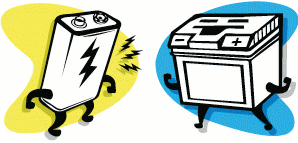 The world is increasingly moving to wireless sensors for everything from water and gas meters to shipping container tracking devices to temperature sensors in industrial freezers (read: Wal-Mart). Over their decades-long life, these devices require several rounds of batteries, which are inexpensive, and labor to physically replace them, which isn’t.
The world is increasingly moving to wireless sensors for everything from water and gas meters to shipping container tracking devices to temperature sensors in industrial freezers (read: Wal-Mart). Over their decades-long life, these devices require several rounds of batteries, which are inexpensive, and labor to physically replace them, which isn’t.

THE SITUATION
The world is increasingly moving to wireless sensors for everything from water and gas meters to shipping container tracking devices to temperature sensors in industrial freezers (read: Wal-Mart). Over their decades-long life, these devices require several rounds of batteries, which are inexpensive, and labor to physically replace them, which isn’t.
THE NEW TECHNOLOGY
WiSPI.net, co-founded by Portlander Doug Morris, would replace these batteries with a fuel cell about the size of a coin. Fed by a small tube of methanol, the WiSPI.net fuel cell charges up an attached battery that runs the larger wireless device. During the device’s downtime, the fuel cell recharges the battery. The fuel cell setup lasts for 25 years, or the theoretical life of most wireless sensors. Morris estimates the $60 initial cost of WiSPI.net’s fuel cell to be five times cheaper than the best battery system.
DOES IT HAVE JUICE?
Morris, who spent 20 years at Motorola and seven in their energy systems group, has a solid technology developed under a Department of Defense DARPA grant at Georgia Tech. “They have a real competitive advantage in powering devices that aren’t easy to get to,” says Wayne Embree, a venture capitalist at Cascadia Partners.
WiSPI.net’s big hurdle now is proving its fuel cell in rigorous testing, before utilities — the company’s first target customers — agree to switch over hundreds of thousands of wireless reading meters to the new technology. But for the same reason, the potential payoff in landing one utility account is huge. Morris estimates the market for wireless power will be $5 billion by 2010. First, he must track down $1 millon for prototypes to test to utility standards.
— Oakley Brooks
Have an opinion? E-mail [email protected]


